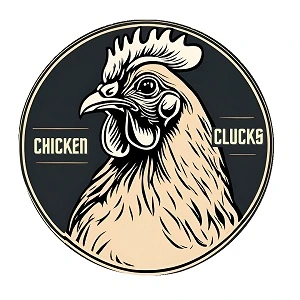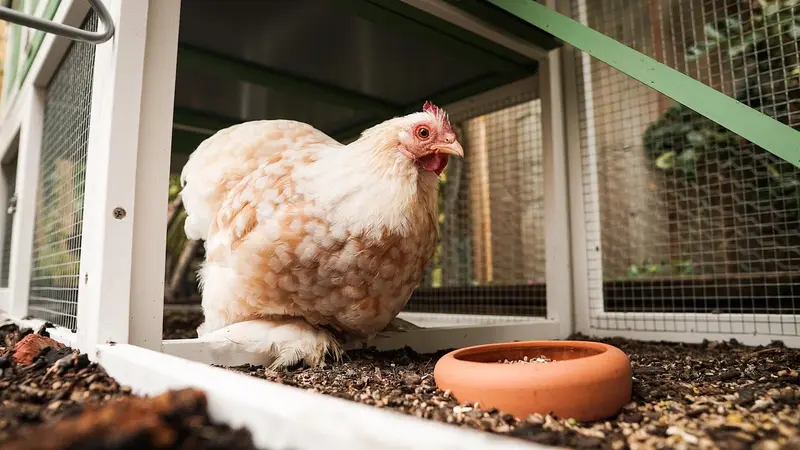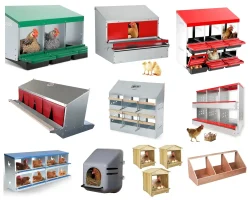Small chicken coops are perfect for hobby keepers who only have a few hens. They are ideal for small backyards, but often raise many questions. How many chickens can fit comfortably? What is the right size? How can they be kept safe and healthy? How should they be maintained throughout the year?
A well-designed small chicken coop provides space for chickens to roost, nest, and move around comfortably, while fitting neatly into a backyard. This guide answers the most common questions about small coops, with detailed advice on space, safety, maintenance, and accessories. Following these tips will help you choose and set up your small coop for success, both for you and your chickens!
How Many Chickens Can I Keep in a Small Coop?
Space Requirements Per Bird Depend On Chicken Breed and Size
Different chicken breeds have varying space needs. Large breeds like Orpingtons or Plymouth Rocks require more space than bantams. Most space advice is based on normal-sized breeds like Leghorn and ISA Brown. I always advise chicken keepers to adjust coop size on the mature hen weight of their chicken breed.
Normal chicken breeds weigh about 4 to 6 pounds (1,8 to 2,7 kg), while bantams are smaller breeds that weigh about 2 pounds (0,9 kg). Large chicken breeds weigh about 7-10 pounds (3,2 to 4,5 kg). Therefore, they have slightly different space requirements:
- Standard-sized chickens: 3-4 square feet (0.28–0.37 m²) per hen inside the coop
- Large chickens: 4-5 square feet (0.37-0.47 m²) per hen inside the coop
- Bantams (smaller breeds): 2-3 square feet (0.18–0.28 m²) per hen inside the coop
- Run or outdoor space: 10-12 square feet (0.9–1.1 m²) per hen for both standard and large breeds, for bantams 5–6 square feet (0.5–0.6 m²) is also sufficient
Example: A 3×3-foot coop (9 square feet) can comfortably house 3 medium-sized hens. If you have bantams, the same space can accommodate 4 birds comfortably.
When planning space, consider how chickens move. Even in a small coop, hens should be able to stretch their wings, jump onto perches, and access nesting boxes easily. Overcrowding is the fastest way to increase stress, feather pecking, and aggressive behavior. So, make sure your hens have enough space.
Read our guide on how to choose chicken coop size for more information.
Practical tip: Ignore the claims of fancy chicken coop brochures, but measure and calculate the space for your chickens yourself!

Using Multi-Level Roosts
In small coops, maximizing space is key. A single-tier roost uses floor space efficiently, but adding a second-tier roost allows more chickens to perch without crowding the floor. Proper spacing ensures that each bird has its own roosting spot.
A Raised Coop Is Ideal For Small Backyards
A raised chicken coop can be a clever way to maximize space, especially if you have a small backyard. This setup allows your chickens to have shelter above while giving them a protected area to roam below.
When designing a raised coop, make sure the run underneath is tall enough for the chickens to move comfortably, ideally around 90–120 cm (35–47 inches) high. The floor of the coop should be secure to prevent predators from getting in, and access ramps should be gentle, around 30–35 degrees, so chickens can easily climb up and down.
What is the Ideal Size for a Small Chicken Coop?
For 3 normal-sized hens, a 3×3-foot coop (9 square feet) works well. If you have 4 hens, you need a 4×3-foot coop (12 square feet). For 5 hens, you need a 5×3 coop (15 square feet). A small coop should allow chickens to move freely, perch comfortably, and access nesting boxes without crowding.
Height also matters, since higher coops allow for more roosts (perches). Staggered or double-tiered roosts maximize space without enlarging the coop footprint. Also, taller coops are easier for you to clean, and have a better airflow and air quality for your chickens.
Extra tip: Planning for future expansion is smart. I have seen many beginning chicken keepers make the mistake of buying a small coop, only to expand their flock within months. If your backyard is large enough, buying a bigger coop upfront can make sense.
Do Chickens Need a Run if They Have a Small Coop?
Yes, they do! You can also let them roam free around your backyard. However, if you have a small garden, that might be impractical. They might make a mess, or you might fall over them.
Chickens always need space to scratch, peck, roam, and stretch their wings. A run gives them room to move safely, express their natural behaviors, prevents boredom, and helps keep your chickens healthy and happy without taking over your whole garden.
How Do I Predator-Proof a Small Chicken Coop?
Keeping your chickens safe in a small coop requires a combination of strong fencing, secure doors, and protective covers. Small coops can be more vulnerable because there’s less space for chickens to escape danger, so careful planning is essential.

Fencing Types and Installation
When it comes to fencing, hardware cloth is the best choice over traditional chicken wire. While chicken wire keeps birds contained, it’s too weak to stop predators like raccoons, foxes, or even neighborhood cats. Hardware cloth is sturdy, long-lasting, and prevents predators from reaching through the gaps.
For maximum protection, bury the fencing at least 6 inches (15 cm) underground. This prevents digging predators from tunneling under the fence. The mesh should be tight, around ½ inch (1.3 cm). Larger gaps allow predators to reach inside, while smaller gaps ensure that bantams or young chicks cannot squeeze through and escape.
Extra tip: Regularly inspect your fencing for holes or wear, especially after heavy rain or storms, and repair immediately to maintain a secure environment.
Door Security and Latches
Doors are often the weakest point of a coop. Even a small gap can give clever predators like raccoons, opossums, or cats access. Use spring-loaded latches, carabiner clips, or padlocks to secure all doors. Metal latches, preferably stainless steel, are preferred over plastic ones because predators cannot break them easily.
Practical tip: Automatic chicken coop doors can add both safety and convenience, especially during dark evenings or if you’re away. They ensure your chickens are safely locked in every night without you having to worry.
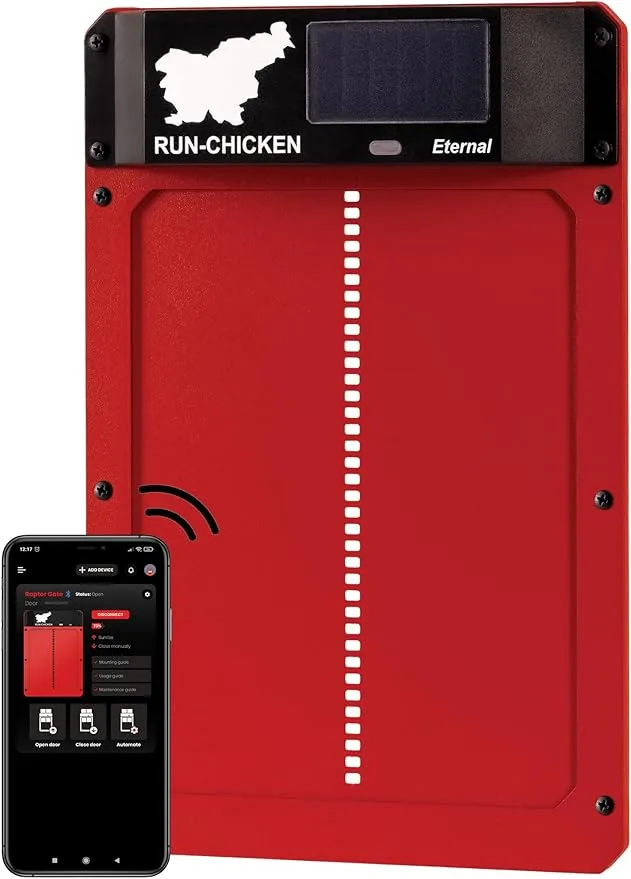
Covered Runs for Predator Protection
A covered run is an essential addition to protect chickens from aerial predators like hawks, owls, or even neighborhood crows. For small flocks, uncovered runs can leave birds vulnerable since fewer chickens make easier targets.
Use UV-resistant netting or a solid roof for long-term durability. Ensure the cover is sturdy enough to withstand snow, strong winds, or heavy rain, particularly in winter months. A secure covered run also allows chickens to move freely and exercise safely without constant supervision.
Extra tip: Consider adding angled supports or tensioned wires to prevent netting from sagging, and make sure all sides are tightly attached to avoid gaps predators can exploit.
Additional Safety Measures
- Motion-activated lights near the coop can deter nocturnal predators.
- Elevated coops reduce the chance of predators digging underneath and give chickens a safe perch.
- Regular inspections are key; check for weak points in fencing, loose latches, or damaged netting weekly.
By combining strong fencing, secure doors, and covered runs, you can create a safe, comfortable environment for your chickens. Keeping a small flock safe is entirely possible with careful planning and regular maintenance.
How Do I Keep a Small Coop Clean and Fresh?
A clean and well-maintained coop is essential for chicken health.
- Bedding: Use straw, hemp or nesting pads. These materials are absorbent and help control odor. Rotate bedding weekly for cleanliness.
- Cleaning schedule: Remove droppings and dirty bedding every day or two, and do a thorough cleaning once a week.
- Ventilation: Proper airflow prevents the buildup of moisture and ammonia, and improves the air your chickens breathe. High vents or small side windows work well.
- Moisture control: Next to ventilating, keep the bedding layer around 2–3 inches. Too much bedding can trap moisture and create respiratory problems.
Pro tip: Cleaning a coop doesn’t only mean taking out dirty bedding, but also scrubbing with water and soap, and even disinfecting (after drying). For small chicken coops, cleaning is extra important since space is limited, and it is a small effort to clean thoroughly weekly. A clean coop keeps your hens healthy!
What Accessories Improve Small Coop Comfort?
Even compact chicken coops can be optimized for comfort and productivity. Nesting boxes, roosts (perches), and chicken feeders and waters cover the basics. Organize these accessories so there is a clear walking space in the run and coop. Overcrowding feeders or nesting areas increases stress and aggression.
Nesting Boxes
Nesting boxes are essential for comfort and consistent egg-laying. For small coops:
- I recommend 2 nesting boxes for 3-5 chickens. If you have more chickens, add 1 more nesting box for every additional 3 chickens.
- Place boxes in quiet, darker, slightly elevated corners to reduce stress.
- Use straw, hemp or nesting pads for bedding and replace it regularly
Practical tips: Many chicken coops for sale have removable trays under the nesting boxes to make cleaning easier. I prefer roll-out nesting boxes since they reduce the risk of eggs being contaminated by droppings or breaking.
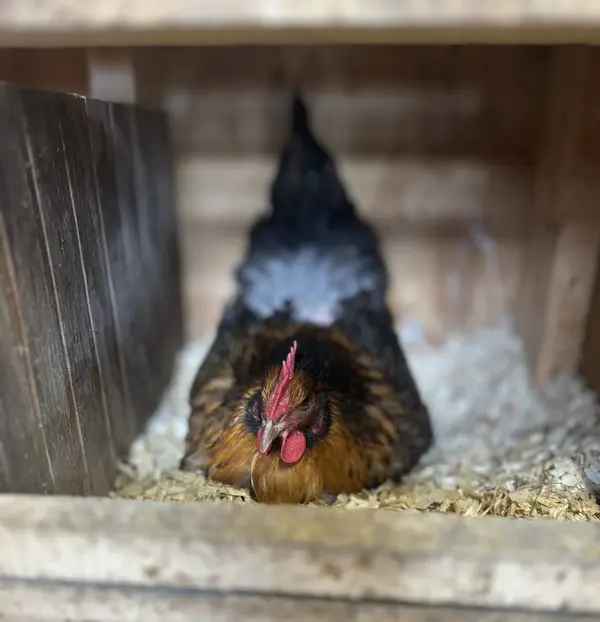
Roosts (perches)
Roosts, also called perches, are raised resting spots where chickens naturally sleep and rest. They mimic the branches chickens would use in the wild to stay safe from predators at night. Providing good roosts supports your hens’ comfort, reduces stress, and helps prevent foot and keel bone injuries.
- Ensure at least 12 inches (30 cm) of space between roost levels to prevent injuries.
- Use flat roosts with rounded edges to reduce pressure on the keel bone
- Roosts should be about 4 inches (10 cm) wide. A flat 2×4 piece of lumber laid flat works well, and slightly wider perches are better for larger breeds.
- Position perches higher than nesting boxes to encourage hens to sleep on them rather than on the perches.
- Provide perches at different heights to accommodate the pecking order, but all should be at least 20 inches (50 cm) above the ground
- Allow 8–12 inches of perch space per bird to prevent crowding and ensure everyone can roost comfortably
Extra tip: Avoid placing perches directly above nesting boxes, since droppings can cause dirty eggs and hygiene problems.
Chicken Feeders and Waterers
Feeders and waterers are essential for keeping your chickens healthy, happy, and productive, also in a small backyard coop. The right setup helps prevent waste, keeps food and water clean, and makes daily care much easier for you and your flock:
- Provide enough feeder space per bird to minimize competition and aggression, especially in small coops.
- If you have a small coop and run for just 2 to 5 chickens, you probably just need 1 feeder and 1 waterer (depending on their size). However, if you notice stress or pecking at feeding time, it can be helpful to have 2 of each.
- Gravity-fed or automatic systems reduce spills and keep food and water clean. My personal favorite is Grandpa’s feeder, a treadle feeder that also keeps out rats.
- Place feeders and waterers at a height accessible to your hens, their back should be as high as the edge of the feeder or drinker
Practical tip: Keep feeding and watering areas separate from perches and nesting boxes to reduce droppings and mess.
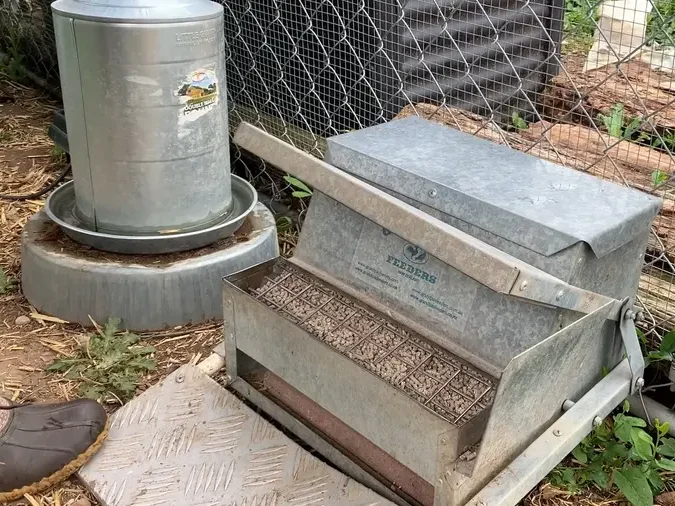
Can I Keep Chickens In a Small Coop Year-round, Even In Winter?
Yes, you can! Chickens are far more cold-hardy than many people think, and they cope with chilly weather much better than with heat. The biggest mistake new chicken keepers make is trying to heat the coop in winter. Heating is not necessary unless temperatures are far below the freezing point, and it can even be harmful. Don’t forget your hens’ bodies also produce heat and warm up the coop, especially in small coops.
In small chicken coops, ventilation is often more of an issue than heating. In winter, a little ventilation allows moist air and ammonia to escape. Ventilation is especially important in summer, to keep your hens cool. To keep your birds comfortable, make sure the coop is draft-free at chicken level but still allows airflow near the roof.
A thick layer of dry bedding, such as straw or wood shavings, provides insulation and helps your hens stay cozy. You’ll also want to keep their water from freezing, preferably by using a heated chicken waterer. And don’t forget: chickens love to go outside even in the snow, so give them access to a safe run or a covered area where they can scratch and explore. With these simple steps, your chickens will thrive in a small coop all year round.
Final Thoughts
Small chicken coops for 2 to 5 hens can provide everything a backyard flock needs when chosen (or built) carefully and maintained properly. Focusing on proper space, predator protection, bedding, ventilation, and accessories ensures hens stay healthy, happy, and productive. Remember to ignore the claims of fancy chicken coop brochures, but measure and calculate the space for your chickens yourself!
